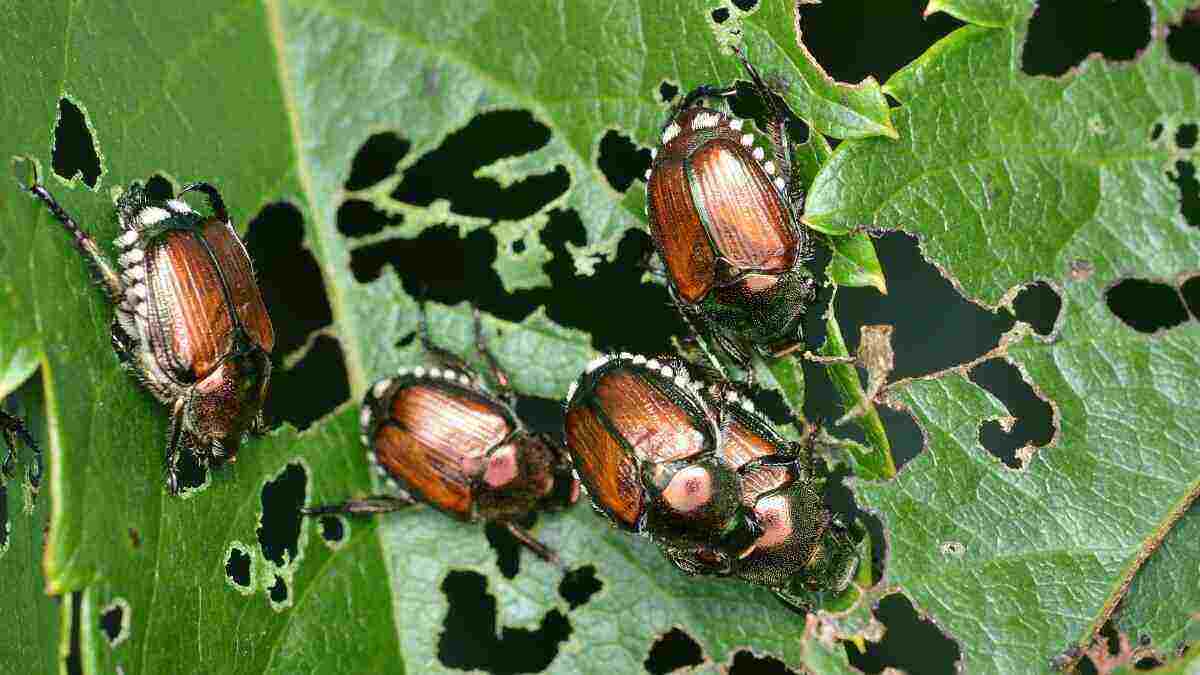
How can you get rid of Japanese beetles on your ornamental plants or in your yard? There are a number of well-chosen ways, including hand picking, exclusion, habitat modification, or pesticides (natural and chemical). With these simple tips, you can say goodbye to skeletonized leaves and brown, patchy lawns for good.
- What are Japanese Beetles?
- What Japanese Beetles Look Like
- How to Identify Japanese Beetle Damage
- How to Get Rid of Adult Japanese Beetles Naturally
- How to Get Rid of Japanese Beetle Grubs Naturally
- How to Get Rid of Japanese Beetles Chemically (Adults and Grubs)
- Basic Facts About Japanese Beetles
- FAQ About Japanese Beetles
Short on time? Try one of these highly rated traps and pesticides:
What are Japanese Beetles?
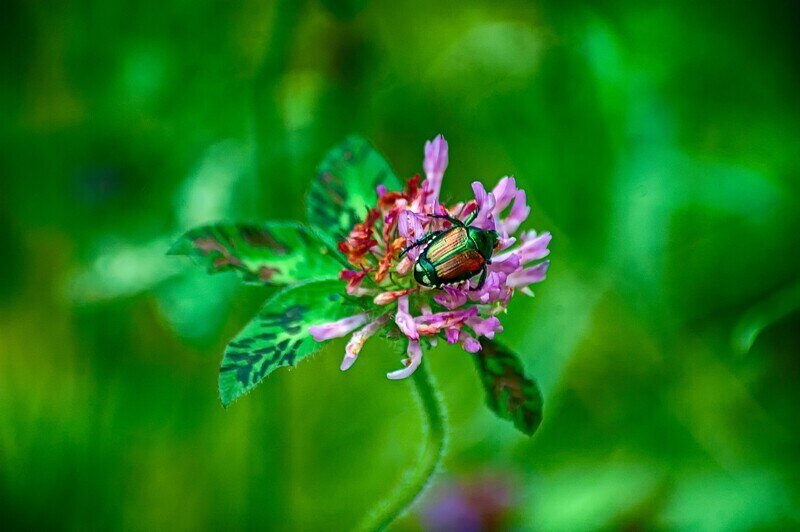
Japanese beetles are an invasive species that feeds on the leaves, flowers or fruit of more than 300 species of plants. Their grubs are pests of turf, chewing on grass roots, causing the turf to brown and die.
What Japanese Beetles Look Like
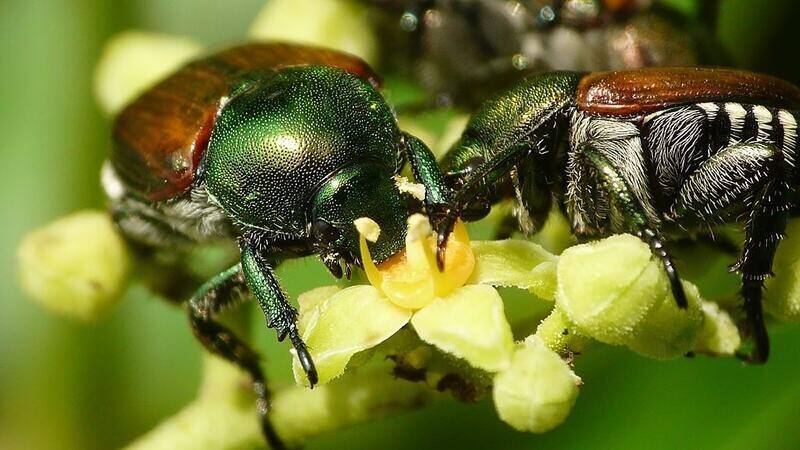
Sporting metallic green heads, copper-colored wing covers, and oval-shaped bodies, adult Japanese beetles grow to about half an inch long.
Japanese beetle look-alikes
Are you sure that’s a Japanese beetle? Here are a few Japanese beetle look-alikes.
- Be careful: You might have False Japanese Beetles. Also known as the sand chafer, Strigoderma arboricola, False Japanese beetle adults are the same size as Japanese beetles, but do not have a metallic green head.
- Also be aware of these bugs that closely resemble Japanese beetles: Hairy bear beetles (Paracotalpa granicollis), which have fuzz along their sides, and green fruit beetles (Cotinis mutabilis), which have a yellow-orange stripe on their wings.
Here are other species that look similar to Japanese beetles:
- Bumble Flower Beetle (Euphoria species)
- Festive Tiger Beetle (Cicindela scutellaris)
- Green Stink Bug (Acrosternum hilare)
- Masked Chafer (Cyclocephala species)
- May/June Beetle (Phyllophaga species)
- Rainbow Scarab (Phanaeus vindex)
- Six-Spotted Tiger Beetle (Cicindela sexguttata)
How to Identify Japanese Beetle Damage
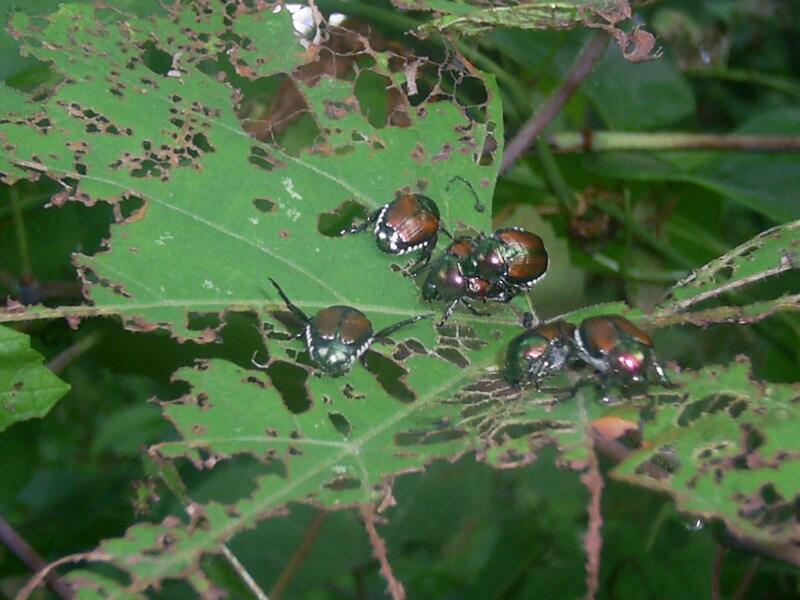
- Skeletonized leaves
- Holes in flower petals
- Brown patches on lawn grass (grubs)
- Turf that can be rolled back like a carpet (grubs)
- Trees that appear to be scorched by fire
How to Get Rid of Adult Japanese Beetles Naturally
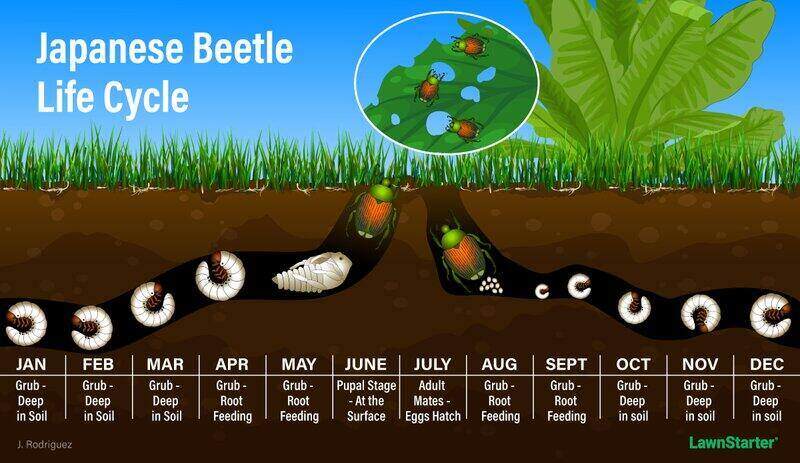
The key is to begin controlling adult Japanese beetle populations on your plants as soon as they begin emerging from the ground between May and June.
1. Physical removal: Hand-picking Works
For homeowners with smaller yards and fewer plants, hand-picking adult beetles from affected flowers, trees, and shrubs may be the most efficient, cost-effective option. Hand-picking helps inhibit leaf and petal damage, which in turn prevents plants from emitting chemicals, signaling they’re a good food source.
Target adult Japanese beetles early in the morning or in the evening. This is when they’re most sluggish and easiest to remove. As you pluck individual beetles from plants, drop them into a bucket of soapy water to kill them.
2. Exclusion: Cover the Plants
While you can’t keep these pests from coming into your yard, you can protect your plants from the damage they cause. Row covers are tunnel-shaped and fit over the top of plants to block Japanese beetles (and other bugs) from getting to them. Purchase row covers or simple netting from your local store, or build your own.
When should you do this: Wait for plants to finish blooming before covering them up, so you don’t prevent pollinators from reaching them.
3. Trapping: Not Always Effective
Japanese beetle traps work by releasing both floral scents and female beetle pheromones to attract these pests. And while the number of dead beetles caught — thousands per day! — seems impressive, the truth is, these lures attract way more Japanese beetles into your yard than they catch.
While trapping will help you determine if there are other pests attacking your garden (also called a “survey”), once you have determined to go after Japanese beetles, experts recommend against using traps.
4. Habitat modification: Add Plants the Japanese Beetles Don’t Like
Selecting plants that are resistant to Japanese beetle attacks can help control an infestation.
According to the United States Department of Agriculture (USDA), there are several trees and shrubs that Japanese beetles avoid, including:
- Boxwoods
- Dogwoods
- Holly
- Pine
- Red maples
Some types of crabapple trees also show resistance.
On the flower front:
Geraniums may also aid in getting rid of Japanese beetles by paralyzing them, leaving them open to attacks from predators.
5. Neem Oil: It’s Natural and It’s a Pesticide
For decades, neem oil has proved a successful repellent of adult Japanese beetles. A naturally occurring pesticide found in seeds from the neem tree, it has been used to battle pests for centuries. Neem oil is available online or at your local hardware store.
If you’d rather DIY it, you can create a spray with a few drops of neem oil, a few drops of dish soap, and a gallon of water. Pour the mixture into a spray bottle and apply it to affected plants.
6. Insecticidal Soap: Might be Too Gentle
Insecticidal soaps are made of salts and fatty acids selected to kill pests while having few adverse effects on people or plants, according to Penn State. They are considered to be an alternative to chemicals. They are most effective on soft-bodied pests such as aphids, but have little benefit against hard bodied ones such as Japanese beetles, according to the University of Connecticut.
7. Vacuuming: Children Can Do This
Did you know this: You can use a small vacuum cleaner to suck up Japanese beetles! It can be time-consuming (and you really don’t want to ever again use that vacuum for anything else), but Jim Dill at the University of Maine Extension points out that it is something kids can do to help.
8. Natural Predators
Parasitic fly: Isotecheta aldrichi is a parasitic fly that attacks adult Japanese beetles. After mating, these flies lay their eggs on the adult Japanese beetle’s thorax. When the eggs hatch, the maggots drill into the beetle’s body, killing it. These flies reduce Japanese beetle populations by killing adults before they have a chance to reproduce.
Note: This natural predator is not commercially available, but your local Extension office can let you know if you can find them in your area. Then, you can plant food sources that will attract this parasite.
How to Get Rid of Japanese Beetle Grubs Naturally
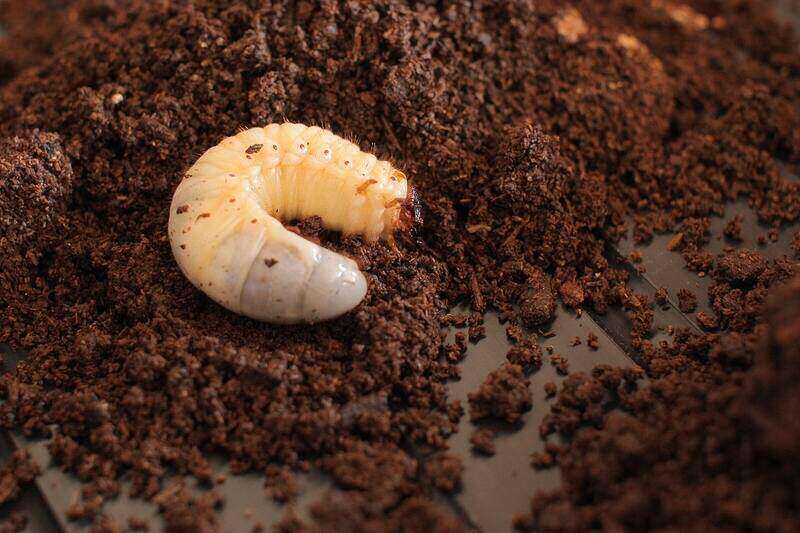
Photo Credit: ElHeineken / Wikimedia Commons / CC BY 3.0
Control measures for adult beetles and grubs differ greatly. To get rid of Japanese beetles at the grub stage, try the following pesticide-free methods:
1. Natural Predators
Parasitic wasp: For eliminating grubs in your lawn, the USDA recommends unleashing the grub parasite tiphia vernalis. A tiny, parasitic wasp, tiphia vernalis burrows in the soil after mating, paralyzes grubs by stinging them, and then lays its eggs on them. When the eggs hatch, the emerging wasps eat the grub.
Note: This natural predator is not commercially available, but your local Extension office can let you know if you can find them in your area. Then, you can plant food sources that will attract this parasite.
Nematodes: Once grubs are present, nematodes are a natural predator that can be used. According to the USDA, “Upon penetrating a grub, the nematode inoculates it with the bacteria. The bacteria reproduce quickly, feeding on the grub tissue.” The nematode eats these bacteria, ultimately killing the grub.
The nematodes:
- Penetrate the grubs
- Inject the grubs with a bacteria
- The bacteria feeds on the grubs
- The nematode then eats the bacteria, killing the grubs
Don’t apply until the ground has reached 60 degrees. It is best to apply them in the evening or when it is overcast. Be sure to water them thoroughly.
Pro Tip: Buy the Heterorhabditis bacteriophora nematode (aka the Hb nematode) online and apply to your lawn to battle Japanese beetles.
2. Milky Spore: Something to Consider for Grub Control
Milky spore is a bacterium registered for use against Japanese beetle grubs, but not everyone agrees on its effectiveness. The USDA recommends using milky spore to fight Japanese beetles on turf grasses, but there are experts who question its effectiveness at this point.
Milky spore works when grubs in the soil ingest it, causing the bacteria to multiply in the grub’s body. The bacterial buildup causes grubs to take on a “milky” appearance, ultimately dying and releasing 1 billion to 2 billion spores back into the soil.
How to Get Rid of Japanese Beetles Chemically (Adults and Grubs)
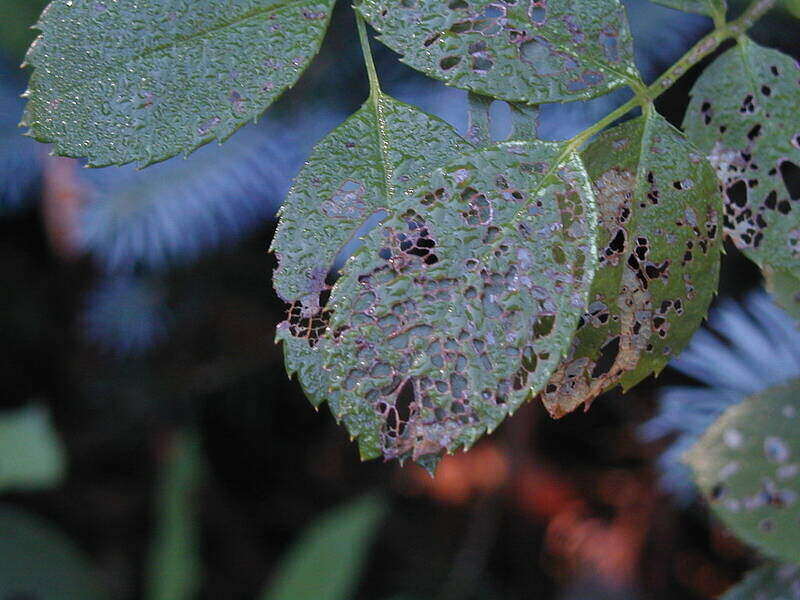
If natural methods aren’t providing the results you need, you may want to consider insecticides. Here’s how to safely use chemical controls to get rid of Japanese beetle adults on your plants and grubs in your lawn.
Pesticide sprays: Take Action as Needed
Plants: Pesticides made with pyrethrins will kill adult beetles on contact only.
Lawns: For chemicals with a residual effect, try products made with chlorantraniliprole, pyrethroids, or carbaryl. Depending on the ingredients, these options can provide around two to four weeks of plant protection. Some residual pesticides are harmful to pollinators, so check the label before you apply.
It is best to apply these chemicals just before or just about the time eggs hatch, which usually comes mid-June to early July, according to Colorado State Extension.
Trees: Soil drench, tree trunk spray, and injections are best left to a pest control pro. These types of pesticides work by moving through a plant’s tissues.
Basic Facts About Japanese Beetles
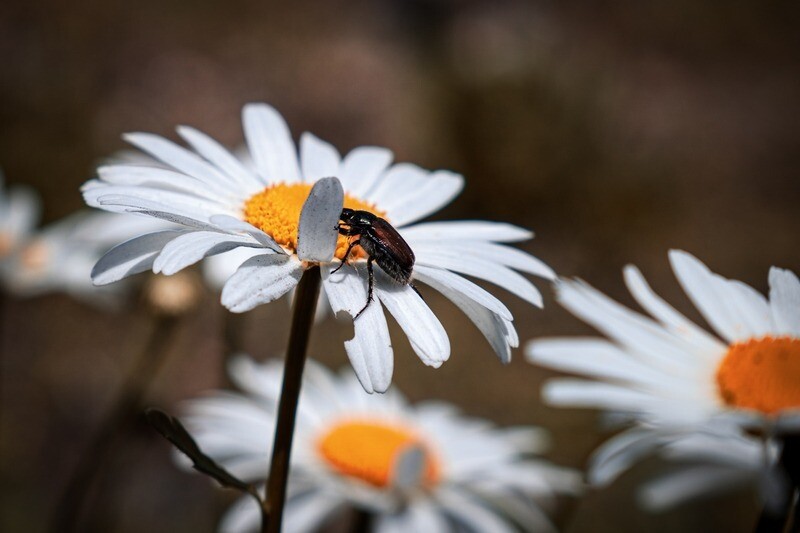
History: Native to their namesake country, Japanese beetles (scientific name Popillia japonica) were accidentally introduced to the United States in 1916 by way of infested, imported plants arriving in New Jersey.
When the adults are active: Mainly active in July and August, these garden and lawn pests spend their time mating and feeding on 300-plus species of trees, shrubs, flowers, and grass.
Life cycle: After mating, female beetles lay eggs 1 to 3 inches underground, according to the University of Minnesota Extension. They can lay up to 60 eggs over the course of their two-month adult lifespan.
Eggs take about two weeks to hatch. The emerging white grubs remain underground all fall, winter, and spring, feeding on soil and grass roots. Once they reach maturity in summer, these new adult Japanese beetles come out of the ground and fly for miles, if necessary, in search of food.
The Japanese beetle life cycle repeats year after year, but you can combat these pests at every stage by taking the proactive and reactive measures mentioned above.
FAQ About Japanese Beetles
Japanese beetle damage is typically cosmetic only — the adults cause skeletonized leaves, and Japanese beetle grubs cause brown patches on lawns.
However, if there’s a big enough population feeding on large amounts of leaves, the loss of chlorophyll and foliage can stress the tree and open it up to secondary diseases that can lead to death.
While these insects will feed on more than 300 types of plants, Japanese beetles are more likely to feast on Japanese maple trees, roses, elms, cherries, plums, peaches, raspberries, and grapes.
Red maple, boxwood, hickory, redbud, tulip, dogwood, burning bush, forsythia, ash, and holly, according to USDA research.
They use their antennae to pick up scents that lead them to the food they want, so, you can spray your plants with scents they don’t like, such as wintergreen and peppermint. Plus, as we’ve discussed, neem oil.
When to Call Pest Control Pros
Japanese beetles are quite destructive and can be difficult to control. If you see them or their signs, don’t wait. Take action, from hand-picking up to and including the bringing in of a pest control pro.
If your Japanese beetle infestation is severe, it could weaken lawn grasses, trees, shrubs, and flowers so much that they die of secondary causes. To avoid this fate, call in your local pest control professionals.
First, these experts will confirm that your problem is truly Japanese beetles. Then, they’ll implement an integrated pest management approach, blending biological, cultural, and chemical control methods.
Main Photo Credit: Ryan Hodnett / Wikimedia Commons / CC BY-SA 4.0
Additional sources: USDA, Colorado State University Extension, University of Minnesota Extension